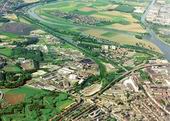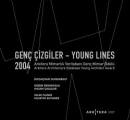|
The Urbanized Landscape: "Hybrid
Landscapes"
05 Mart - 01 Mayıs 2005, Wiebengahal, Maastricht - Hollanda |
Designing for sprawl in the Netherlands 1980 - 2004
 The
NAI Maastricht/Wiebengahal will be open to the public from March 5, 2005 until
May 1, 2005. The
NAI Maastricht/Wiebengahal will be open to the public from March 5, 2005 until
May 1, 2005.
The exhibition hall will then be closed until 2006 in connection with a major
renovation. From the spring of 2006 onward, the NAI Maastricht/Wiebengahal will
be open permanently.
No other country in the world has fostered such an artificial landscape as
the Netherlands. The exhibition focuses on the interrelation between urban
development and the landscape. 'Hybrid Landscapes' will feature three urban
developments: Prinsenland (1982-1984), Leidsche Rijn (1994-1995) and Maastricht
Belvédère (1999-2009) and a future scenario.
In each of the projects the designers use the morphology of the artificial
landscape to add differentiation to the designs and to anchor them in their
environment. This is an extremely Dutch interpretation of the role landscape can
play in the process of urbanization and sprawl. The designs were developed in a
period when strict lines were drawn between the city and the countryside for
fear that the Netherlands would be completely urbanized. Thus the projects were
designed within clearly defined urban contours, but the designers - Riek Bakker,
Frits Palmboom and Michael van Gessel - did not treat the city and landscape as
polarities but rather as mutually enhancing entities.
City and countryside
The three projects illustrate a highly conscious approach to the artificial
landscape, which is a natural landscape that is transformed, following a lengthy
process of agricultural cultivation and land consolidation, into a cultural
landscape. The designers analyze the cultural landscape and existing features
such as historic farms, houses, warehouses, factories, lock complexes, bulwarks,
ribbon developments, height differences, waterways, infrastructure and field
patterns become important aspects of the new design. The three designs exude
common sense, clear thought and self-awareness. Moreover, the projects highlight
three different urban scales. For decades government policy has stressed an
almost fearful separation of city and countryside; urbanization was permitted
only within clear boundaries as close as possible to existing cities. These
projects should not be viewed in isolation, but rather as part of important
developments in the Netherlands.
New tasks
The Netherlands faces two important tasks in the coming decades: firstly, a
further intensification of the cities, and secondly building in the rural
landscape. These arise from advancing urbanization, the restructuring of the
agricultural industries and the government's abandonment of the strict
delineation between city and countryside. Although there is still a desire for a
contrast between the city and the countryside, the two are no longer treated as
opposites, but as components of a hybrid. The potential qualities of a given
location will start playing a crucial role in the condensation of existing urban
areas, including outlying suburbs, and in allowing developments taking place in
the rural landscape. The Dutch approach analyzes, preserves and adapts existing
landscapes. These function as a base for new developments in which old and new
elements interrelate, anchoring the location in its history and environment.
This approach offers universal lessons for other countries increasingly
confronted with urban sprawl
Opening hours
Tuesday to Sunday: 11 a.m.-5 p.m.
Also on national holidays that fall on Mondays.
How to get there
The Wiebengahal is located next to the Bonnefanten Museum, in the center of
Maastricht, 15 minutes' walk from Central Station.
Calendar
June 3, 2005 until January 9, 2006 - Kasteel Groeneveld, Baarn, NL
The Netherlands Architecture Institute (NAI) is spreading its wings toward
Maastricht, where from March 5 onward it will present The Urbanized Landscape:
three exhibitions in the Wiebengahal that focus on the design of the urbanized
landscape. The Dutch submission to the 2004 Venice Architecture Biennale, Hybrid
Landscapes, and The City As Loft about the work of architecture firm KCAP/ASTOC
- Kees Christiaanse will be on display for the first time in the Netherlands,
and Transformations of the Urbanized Landscape by the Delft University of
Technology will present the work urban planning office Palmboom & Van den Bout.
For mode detail:
Agnes Wijers, Coordinator International Projects
Address: Avenue Céramique Maastricht.
Tel: +31 (0)10 4401200
E - mail: [email protected]. |
|
Kitap |
|

|
|
Genç Çizgiler 2004
Editör: İdil Erkol
Grafik Tasarım: Aslı Ayhan
Arkitera Mimarlık Merkezi Yayınları
Ücret:
20 milyon TL
(20 YTL). Dağıtım ve kargo masrafları
dahil. |
|
|
|